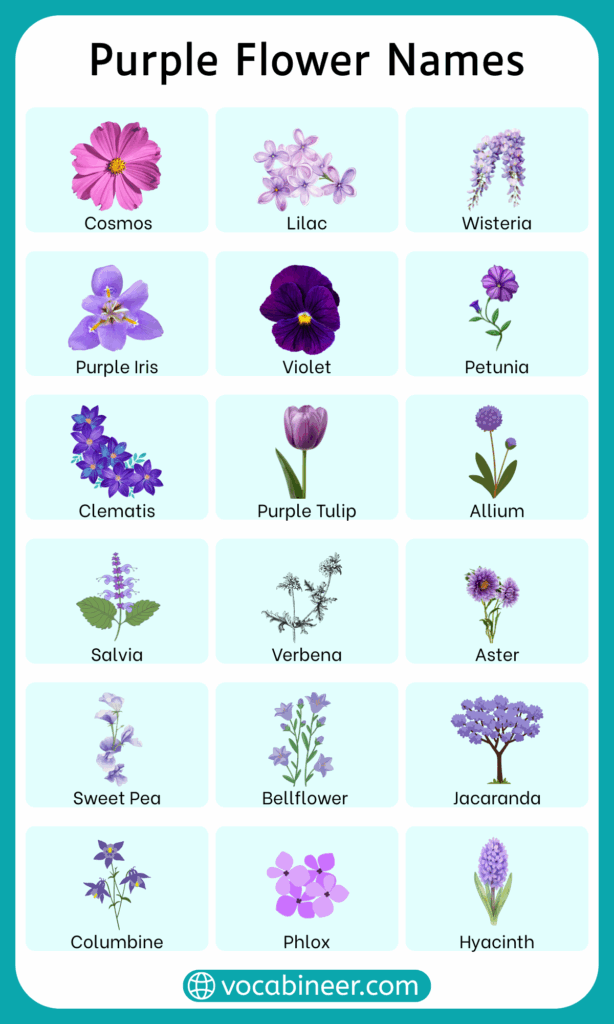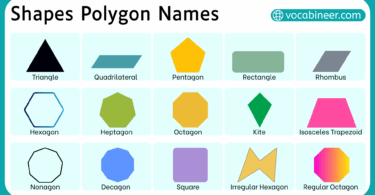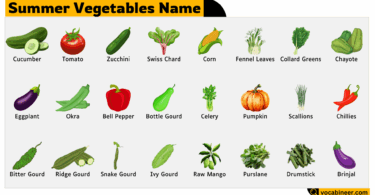Learning about purple flower names helps us notice how many plants bloom in this color. Some blossoms appear soft and light, while others are deep and bold. Each flower carries a name with its own story, often tied to culture and tradition. In this post you will learn different types of purple flowers and their names in English with pictures. Knowing purple flower names will help you talk about gardens, plants, and decorations in daily life.
In This Page
List of Common Purple Flower Names in English
Below is a list of common purple flower names used in English for everyday plants and blossoms.
- Lavender
- Lilac
- Wisteria
- Clematis
- Salvia
- Verbena
- Catmint
- Balloon Flower
- Campanula
- Foxglove
- Hyacinth
- Crocus
- Iris
- Petunia
- Phlox
- Aster
- Heather
- Pansy
- Violet
- Viola
- Tulip
- Dahlia
- Gladiolus

Purple Flower Garden Varieties
Garden flowers with purple shades are easy to recognize and often planted for beauty and fragrance. Here is a wide selection of purple flowers often grown in gardens.
- Lavender: Known for its calming scent, it grows in long stalks covered in small purple blooms.
- Lilac: A shrub that produces clusters of purple blossoms in spring, with a soft sweet fragrance.
- Wisteria: Climbing vines with drooping clusters of violet flowers that look almost like waterfalls.
- Clematis: Vines with large, star-shaped blossoms that can range from light lavender to deep violet.
- Salvia: Tall spikes filled with small purple flowers, often attracting bees and butterflies in gardens.
- Verbena: Low-growing plants with clusters of tiny purple flowers that bloom from spring until frost.
- Ageratum: Compact bedding plants that produce fluffy lavender-blue blooms, often used for borders.
- Catmint (Nepeta): Hardy perennials with spikes of bluish-purple flowers that grow well in dry soils.
- Balloon Flower (Platycodon): Buds open into balloon-like shapes before turning into starry violet flowers.
- Campanula (Bellflower): Bell-shaped blossoms that range from pale lilac to deep purple shades.
- Foxglove (Digitalis): Tall spikes of tubular blossoms with purple patterns that are loved by pollinators.
- Hyacinth: Bulb flowers with tight clusters of fragrant blooms in shades of purple and lavender.
Purple Flower Trees Names
Trees with purple blossoms stand out in landscapes and city streets. The following are well-known purple flowering trees.
- Jacaranda: A tall tree covered in trumpet-shaped violet blooms that create a carpet when they fall.
- Crape Myrtle: A smaller tree with purple clusters that bloom in summer and last for several weeks.
- Royal Empress Tree (Paulownia): Fast-growing tree producing lavender blossoms before its leaves appear.
- Purple Robe Locust: A tree with hanging clusters of rich purple flowers in early summer.
- Chaste Tree (Vitex agnus-castus): Shrub-like tree with long spikes of lilac-colored blossoms in midsummer.
- Bauhinia (Purple Orchid Tree): Tropical tree with orchid-like blossoms that carry bright violet shades.
Types of Seasonal Purple Flowers
Purple flowers appear across all seasons, from spring bulbs to winter blooms. Learning their names by season helps you recognize them more easily. Below is a list of types of seasonal purple flowers.
- Spring: Crocus, Iris, Hyacinth, Bluebell
- Summer: Verbena, Petunia, Larkspur, Delphinium, Balloon Flower
- Autumn: Aster, Chrysanthemum, Michaelmas Daisy, Autumn Crocus
- Winter: Heather, Pansy, Cyclamen, Hellebore
Rare Purple Flowers
Some purple flowers are unusual and admired for their striking looks. The following examples are less common but highly valued.
- Orchids: Exotic flowers with intricate patterns that include shades of lavender and deep violet.
- Passionflower: A complex blossom with purple filaments and unique shapes that look almost unreal.
- Monkshood (Aconitum): Tall spiky flowers in deep purple shades that bloom in cooler climates.
- Tibouchina (Glory Bush): Shrubs with bold, velvety blossoms in rich purple hues.
- Lisianthus: Elegant flowers with ruffled petals often used in bouquets and arrangements.
- Bat Flower (Tacca chantrieri): Dark purple blooms with wing-like petals and long whiskers.
Indoor Purple Flowers Plants
Certain purple flowering plants thrive indoors and bring color to homes. The following are common indoor choices.
- African Violet: Compact plants with fuzzy leaves and clusters of purple blossoms that bloom year-round.
- Gloxinia: Houseplants producing large bell-shaped blooms in purple shades with velvety petals.
- Streptocarpus (Cape Primrose): Long-blooming plants with tubular blossoms in lavender and violet shades.
- Purple Shamrock (Oxalis triangularis): Small plants with purple leaves and delicate pink-purple flowers.
- Purple Heart (Tradescantia pallida): A trailing plant with violet stems and small purple blossoms.
FAQs on Purple Flower Names
Some familiar purple flowers include Lavender, Lilac, Wisteria, Clematis, Salvia, Hyacinth, Balloon Flower, and Petunia. These names help you recognize purple blossoms in gardens or bouquets.
Look at the plant’s size, bark, and branching: trees usually have a single trunk that becomes woody and taller over time. Shrubs are lower, often multi-stemmed. For example, Jacaranda and Crape Myrtle are purple flower trees; Lilac is usually a shrub.
Flowers known for deep or dark purple tones include Monkshood, Bat Flower (Tacca chantrieri), Dark Salvia, Royal Empress Tree blooms, and Purple Orchid Tree blossoms.
Indoor plants with purple flowers include African Violet, Gloxinia, Streptocarpus (Cape Primrose), Purple Shamrock (Oxalis triangularis), and Purple Heart vine.
Yes. Some bloom in spring and summer like Iris, Allium, Hyacinth, Bluebell. Others bloom in autumn or winter such as Aster, Cyclamen, Pansy, Heather.
Read More




